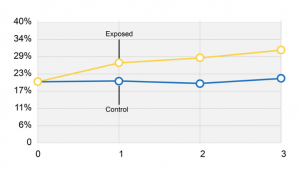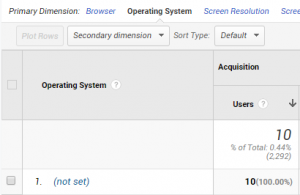The ideal digital marketing career path is still pretty undefined, given that the industry is quite young. Columnist Matt Umbro takes a stab at laying out a successful trajectory — from first entering the industry to becoming a team leader.
As with any industry, digital marketing specialists follow a career path designed to foster growth and take on more responsibility. What’s unique about digital marketing compared to other industries is that the field has only been around for roughly 20 years. Thus, the specific path for progression isn’t as defined. In this post, I’ll share my thoughts around the digital marketing career path, including what specific roles should entail and the time frame for advancement.
Please note that the career progression I lay out is not absolute. Careers evolve at different paces depending on a variety of factors. This path is simply what I find tends to produce the best, most consistent employees.
Entering the industry: 0–3 months
For those beginning a career in digital marketing, the first three months are meant for training and getting a lay of the land. Generally, good training programs will be at least eight weeks and include a variety of readings, exercises and the ability to analyze and even do work for active accounts.
Furthermore, training helps erase preconceived notions and sets the appropriate foundation for a willingness to learn and be open about ideas.
For example, a preconceived notion about digital marketing may be that success is determined by the number of ad clicks. This notion ignores the bigger picture that all digital marketing efforts should have concrete goals that will show a return on investment. Once trainees understand the world in which digital marketing operates, the better they can work toward effective solutions.
Once training is complete, employees get their first unfiltered look at their jobs. Previously, training was a significant portion of the job, and it was expected to be the focus. With this phase complete, employees can get into the weeds of account work by helping colleagues. Though they are far from managing their own accounts, they can begin to act as a valuable team member by being another set of hands.
An added benefit is that usually coming out of training, employees can assess accounts and make recommendations without the pressures of client interaction. As we’ll discuss in the next section, interacting with clients is an integral part of one’s career progression.
However, during this initial window, there is no client pressure. This time should be used to provide a fresh set of eyes and bring new ideas to account managers.
Learning the industry: 3–12 months
I like to compare this nine-month period to that of a young child’s developmental years. This period allows employees to dig deeper into their craft and understand the day-to-day happenings. It’s when they learn what being a digital marketing specialist means.
There will be some good wins, and mistakes will inevitably (and should) happen as employees set the framework for what’s to come beyond year one.
During this time, employees primarily help account managers. It’s when they pay their proverbial dues and do a lot of work behind the scene. This work may include:
- reporting
- monotonous but necessary tasks
- account analysis
- providing recommendations
Employees in this position should be excited about taking on as much (and as diverse) work as their time allows. Again, without client pressures, employees are free to focus on their work.
By the end of the nine months, all the work will lead to patterns and focuses of interest. What I mean by this statement is that employees will be comfortable with the work they are doing and recognize how a theme in one account can apply to others.
They will also get a sense of the type of work they most enjoy. For example, perhaps an employee gravitates more toward account analysis and reporting rather than day-to-day management.
Within the latter half of the nine months, employees should also begin interacting with clients. The account manager is still the main client contact, but employees can sit in on calls and be introduced as a member of the team.
Employees get a feel for how the interaction progresses while still being somewhat isolated. If comfortable, employees can even speak with clients or email about non-complex issues. This communication is important for the next career stage.
Account manager: 1–3 years
After employees have trained and are comfortable with account work, the next step is taking over their own accounts. Generally, these accounts will be smaller in scope and more manageable. Following the pattern of the first year, employees are taking manageable steps through each part of the process instead of jumping right in.
Being an account manager is an important milestone, as it’s the first time employees will lead strategy and be responsible for results. Account managers are also the central point of contact with their clients. Aside from the added responsibility, it’s a crucial point for career development. Employees are determining whether they prefer a more active and visible role or if they are comfortable behind the scenes.
Being an account manager opens the door to scrutiny. You are at the front line of everything that happens in the account. If results are poor, you are questioned. If you are not proactive enough, you are questioned. Even if things are going well, you are questioned to see if you can keep up the positive results.
Most likely, you will have difficult conversations with clients where there isn’t a clear answer. It takes a certain temperament and resolve to face this scrutiny daily. Some new account managers think they have it but don’t.
Account management isn’t for everyone. Some prefer the behind-the-scenes work where they can still make a difference but have less client interaction. Having said this, I strongly believe that putting yourself out there knowing that you will be out of your comfort zone is how you progress in your career. Challenging yourself is how you will advance.
Senior account manager: 3–5 years
The main difference that separates a senior account manager from a non-senior is experience. Senior account managers have managed many campaigns and dealt with the various issues that have occurred. Though they still experience new issues, they are industry veterans who know how to go about solving the problems.
Being a senior account manager is the highest position one can achieve within a singular field. Though employees always need to continue learning, they have reached the tactical pinnacle.
For example, if you’ve been doing PPC for at least three years, you have a pretty good idea of how to run accounts. The next career challenge is learning other skills such as management and training, or even breaking into another subset of the industry (e.g., conversion rate optimization, learning how to code).
Once employees have been senior account managers for an extended period, they face another career crossroad. They must determine whether they want to move into management and relinquish most (if not all) tactical work or if they want to continue in the role. The decision comes down to the desire to try new things.
Team lead/manager/director: 5–7 years
If employees want to get into management, the next step is to run a team. The role of team lead is less about the details of account management than how to best service the clients while maintaining team and individual cohesion.
Team leads look to grow their programs by thinking on a more holistic scale. Questions that team leads should be asking include:
- How can we be proactive for our clients?
- Do my direct reports have the resources they need to most effectively do their jobs?
- Are my direct reports in the best positions to succeed?
- What will it take to grow the program?
Team leads use their years of experience to provide wisdom to the next generation of account managers. They help in whatever way they are needed. It may be providing guidance on a tricky account or talking through the best way to answer a client.
The more effective a team lead is at helping direct reports, the better the program will be overall.
Team leads face some potentially difficult situations. When there is a client fire, team leads are often brought in to help put it out. Sometimes, the team lead is the recipient of a client venting session.
Similarly, when direct reports aren’t performing to expectations, it’s the job of the team lead to get them on track. Not all situations will be positively remedied. Team leads must be OK with confrontation and the hard decisions that occur. These parts of the job aren’t pleasant, but they are necessary.
Beyond: 7+ years
Many employees who are team leads at the seven-year mark have progressed nicely throughout their careers. It’s quite the achievement to go from not knowing anything about the digital marketing industry to leading a team of employees who began their own journeys well after you.
The next career step can go in a variety of directions and depends on that person’s individual goals. This next step may be anything from staying in the same position to creating one’s own company.
Conclusion
It’s fascinating to observe this digital marketing career path. I’ve seen colleagues over the years work hard to continually get to the next level.
Understanding this growth progression is exciting to be a part of when first entering the industry — and rewarding when getting to the pinnacle. As our industry continues to evolve, I will be just as curious to witness the career trajectories.
Some opinions expressed in this article may be those of a guest author and not necessarily Marketing Land. Staff authors are listed here.
Marketing Land – Internet Marketing News, Strategies & Tips
(87)








